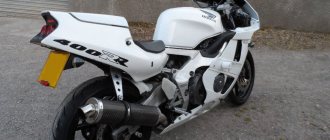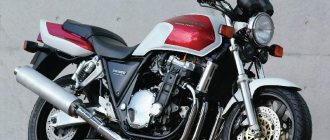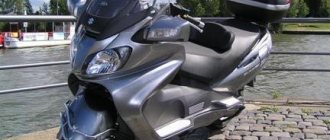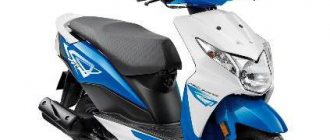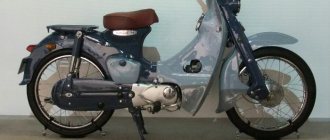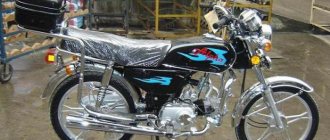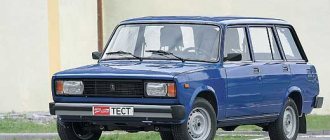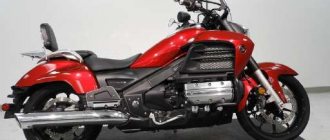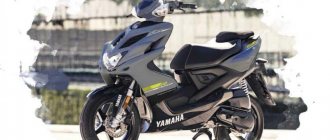Honda CB 750 review
The mid-sized CB 750 road bike was designed as an alternative to the underpowered Honda CB 400 and the overweight Honda CB 1300 with excellent durability and simplicity. The CB 750 is a remake of one of the most popular motorcycles of the 70s, and the manufacturer admitted that it deliberately created the second generation with an archaic design.
The Honda CB 750 was not created as a competitor to its classmates - rather, it was a model created for those who want to buy a motorcycle built on the basis of old technologies. The idea of the Japanese company turned out to be successful: the CB 750 was extremely popular and was produced in several versions - classic, CB 750 Nighthawk and a simpler one, used for training in motorcycle schools in Japan.
Model history
1991 - launch of the Honda CB 750 NightHawk. Model: Honda CB750 Nighthawk (North America). Frame number: JH2RC381MMXXXXXX.
1992 - launch of the Honda CB 750 F2 Seven Fifty modification. The model is available in Europe and Japan. Model: Honda CB750 Nighthawk (North America), Honda CB750 F2 Seven Fifty (Europe, Japan). Frame number: JH2RC381NMXXXXXX (North America), RC42XXXXXXX (Europe), RC42-100XXXX (Japan). Model code: CB750F2N (Europe).
1993 - European version temporarily discontinued. Model: Honda CB750 Nighthawk (North America), Honda CB750 F2 Seven Fifty (Japan). Frame number: JH2RC381NMXXXXXX (North America), RC42-100XXXX (Japan).
1994 - The American version of the Nighthawk is temporarily discontinued. Model: Honda CB750 F2 Seven Fifty (Japan, Europe). Frame number: RC42-100XXXX (Japan), RC42XXXXXXX (Europe). Model code: CB750F2R (Europe).
1995 - CB750 F2 Seven Fifty changes a bit. The color red appears and the rims are available in black (instead of silver). Model: Honda CB750 Nighthawk (North America), Honda CB750 F2 Seven Fifty (Europe, Japan). Frame number: JH2RC381SMXXXXXX (North America), RC42XXXXXXX (Europe), RC42-110XXXX (Japan). Model code: CB750F2S (Europe).
1996 - Japanese version no longer produced. Model: Honda CB750 Nighthawk (North America), Honda CB750 F2 Seven Fifty (Europe). Frame number: JH2RC381TMXXXXXX (North America), RC42XXXXXXX (Europe). Model code: CB750F2T (Europe).
1997 - no significant changes. Model: Honda CB750 Nighthawk (North America), Honda CB750 F2 Seven Fifty (Europe). Frame number: JH2RC381VMXXXXXX (North America), RC42XXXXXXX (Europe). Model code: CB750F2V (Europe).
1998 - no significant changes. Model: Honda CB750 Nighthawk (North America), Honda CB750 F2 Seven Fifty (Europe). Frame number: JH2RC381WMXXXXXX (North America), RC42XXXXXXX (Europe). Model code: CB750F2W (Europe).
1999 - no significant changes. Model: Honda CB750 Nighthawk (North America), Honda CB750 F2 Seven Fifty (Europe). Frame number: JH2RC381XMXXXXXX (North America), RC42XXXXXXX (Europe). Model code: CB750F2X (Europe).
2000 - Only the American version of the Nighthawk is available. Model: Honda CB750 Nighthawk (North America). Frame number: JH2RC381YMXXXXXX (North America).
2001 is the last year of production of the European version of the F2 Seven Fifty, and the model is again available in Japan. The bike gets a new exhaust and carburetors to meet the updated emission norms. The rear suspension is simpler, without a compensation tank. The belt on the passenger side of the seat has been removed.
Model: Honda CB750 Nighthawk (North America), Honda CB750 F2 Seven Fifty (Europe, Japan). Frame number: JH2RC3811MXXXXXX (North America), RC42XXXXXXX (Europe), RC42-125XXXX (Japan). Model code: CB750F21 (Europe), CB750FII1 (Japan).
2002 - Only the American version is produced. Model: Honda CB750 Nighthawk (North America). Frame number: JH2RC3812MXXXXXX (North America).
2003 - no significant changes. Last year of release. Model: Honda CB750 Nighthawk (North America). Frame number: JH2RC3813MXXXXXX (North America).
2004 - The F2 Seven Fifty version begins production again, but only for the Japanese market. The model gets new colors, multi-reflector headlight, electric speedometer, electronic odometer, immobilizer (HISS) and new carburetors with throttle position sensor. The rear suspension is being changed, which again receives compensation shock absorber reservoirs.
Model: Honda CB750 F2 Seven Fifty (Japan). Frame number: RC42-135XXXX. Model code: CB750FII4.
2006 - new colors appear. Model: Honda CB750 F2 Seven Fifty (Japan). Frame number: RC42-160XXXX. Model code: CB750FII6.
2007 - the appearance of a special version of the motorcycle - Honda CB750 Seven Fifty Special Edition. Model: Honda CB750 F2 Seven Fifty (Japan). Frame number: RC42-170XXXX. Model code: CB750FII7.
2008 is the final year of production of the Honda CB750 F2 Seven Fifty. Model: Honda CB750 F2 Seven Fifty (Japan). Frame number: RC42-171XXXX. Model code: CB750FII8.
Technical characteristics of Honda CB 750
The design of the motorcycle is quite primitive: a duplex steel frame, a four-cylinder in-line engine with an air-oil cooling system, front telescopic forks and two rear shock absorbers, a five-speed transmission, a chain drive and four carburetors. The classic design of the Honda CB 750 excludes the plastic body kit, but is equipped with an analog instrument panel and round optics.
Honda CB750 Four
This bike is not a Harley at all, it's 1972 Honda CB750 Four It was on this motorcycle that Arnold Schwarzenegger's hero chased Sarah Connor and Kyle Reese at the end of the first Terminator . The motorcycle is much cheaper than analogues from Harley-Davidson , perhaps precisely because, due to the limited budget, it was taken for the filming of the film.
The CB750 is considered the progenitor of all modern superbikes, and there are a number of reasons for this. At the time of the start of production of this motorcycle, in 1969, it was the most advanced of the production machines, the design of its 8-valve four-cylinder in-line engine, today considered more than ordinary, amazed many then. An electric starter, a front disc brake (a first for a production car) and a four-into-four exhaust system completed the look of a high-tech machine that was years ahead of its British competitors with their low-revving engines.
The CB750, with its four-cylinder inline engine, was the only mass-produced motorcycle equipped with a powertrain of this type. The engine had a dry sump lubrication system. The horizontally separated crankcase contained crankshaft support roller bearings and a camshaft chain drive. The piston stroke length was longer than the cylinder diameter, 63 mm and 61 mm, respectively, the multi-plate clutch operated in an oil bath. The torque from the five-speed gearbox was transmitted to the sprocket of the rear 18-inch wheel by a roller chain, which was lubricated in motion by oil supplied by its own mechanically driven oil pump.
Four Keihin flat-spool carburetors supplied the engine with a fuel-air mixture. While the CB750's engine design was truly revolutionary, the motorcycle's frame followed a more conventional design. Duplex, welded from steel pipes, it rather served as a platform on which all components should be mounted, rather than as an active component of the chassis. And although the frame was quite rigid, the bike's handling was not as impressive as some of its lesser-known rivals.
Also, the exotic hydraulic disc brake was not much more effective than the classic and drum brake. But in general, it was the high technical characteristics, as well as the affordable price and amazing reliability, that made the SV750 very popular. This motorcycle is a harbinger of the era of Japanese motorcycle manufacturers.
Technical characteristics of the Honda CB750 Four motorcycle:
| Maximum speed | 180 km/h (115 mph) |
| Engine | 736 cm3, four-cylinder, in-line, air-cooled, 8-valve, SOHC |
| Maximum power | 49 kW (66 hp) at 8000 rpm |
| Frame | duplex, steel pipes |
| Tires | front 3.25, rear 4.00x18 |
| Drive unit | Chain |
| Transmission | 5-speed |
| Weight | 219 kg |
Engine
The Honda CB 750 was equipped with an engine producing 75 horsepower and 65 Nm of torque, which is a very good indicator even for modern motorcycles. The motor was equipped with a valve drive system with a hydraulic compensator, which eliminates the need for constant adjustment and reduces the noise level. The engine has a long service life and reliability, but requires proper and high-quality maintenance. When saving on consumables and operating fluids, you may be faced with the need for expensive repairs.
Transmission
The gearbox installed on the Honda CB 750 has the same characteristics as the engine, being reliable, long-lasting and quiet. Gear shifting is smooth and soft.
The weak point of the motorcycle is the gear shift shaft, which fails when dropped on the left side. Versions released for the Japanese market most often suffered from rapid clutch wear. Replacing this unit is complicated by the fact that it differs from those installed on European Honda CB 750 models, which makes it extremely difficult to find.
Additional options and versions
The model intended for the American market was equipped with ineffective brakes with a front disc mechanism and a rear drum mechanism, and therefore they prefer to purchase versions of the Honda CB 750 with two disc mechanisms in the front and one in the rear. The braking systems of other versions are many times more powerful, which is their undoubted advantage.
It is worth noting that the manufacturer offers a wide range of additional equipment for tuning, but when choosing it, it is worth considering that the Japanese and European versions of the motorcycle differ from each other.
Features and Specifications
The bike was revolutionary in many ways. Just look at disc brakes, which were considered a breakthrough solution in the 60s. By the way, Honda was the first in the world to introduce this miracle of engineering technology on the CB750 Four model.
As for the main feature of the model, the engine design, it was developed much earlier than the motorcycle. Similar transverse direct engines with overhead camshafts were used even before the Second World War, but they were equipped with racing bikes. Namely, it was in the series that such a unit was presented for the first time by Honda.
Japanese developers also included continuously variable braking, an electric starter, a Kill switch and much more in the design of the CB750. However, with amazing technical characteristics and a lot of revolutionary solutions, the motorcycle cost less than $1,500, which even at the current exchange rate is about tens of thousands. The relatively low price was another indisputable advantage of the model, which allowed it to sell about half a million units in just over 10 years.
Summary
The Honda CB 750 road bike is not an ordinary styling of famous retro motorcycles, but a powerful model with excellent characteristics. The CB 750 was created on the basis of the model of the same name, released more than half a century ago. Despite certain pros and cons, the simple design of the model is quite reliable, and the retro design can be considered an advantage.
Owner reviews
A distinctive feature of the Honda CB 750 is a comfortable and comfortable seat that allows you to carry a passenger. The engine runs silently, average fuel consumption is 6 liters per 100 kilometers at a speed of 100-120 km/h. Engine oil consumption is reasonable, the air-oil cooling system protects the engine from overheating.
Among the disadvantages, owners of the Honda CB 750 in reviews say that the suspension is too soft, and therefore motorists often replace the springs with new ones. The fork is quite soft and sometimes breaks, but there is nothing critical about it. When using low-quality oil, the clutch begins to slip when driving at speeds over 160 km/h and during intense acceleration. This drawback can be eliminated by using high-quality motor oil.
The owners note that the braking system, represented by a drum and disc mechanism, is quite sufficient for the motorcycle, despite the fact that it is often criticized. If necessary, the motorcycle stops quickly and confidently without skidding.
The Honda CB 750 can travel 700 kilometers or more per day without overheating the engine, confidently holds its course, and does not wander along the road. Acceleration from a standstill is smooth, without jerks, the maximum speed is 180 km/h. Owners note the presence of a limiter and excellent acceleration dynamics, which are maintained throughout the entire speed range.
Despite the motorcycle’s considerable dimensions, it handles well in traffic jams and heavy city traffic: owners note excellent maneuverability. The seat is quite low, but at the same time comfortable and comfortable, the transmission works excellently. The stated problems with finding spare parts are not justified: motorcyclists easily find the necessary components in specialized stores, noting their affordable cost in reviews.
Motorcycle Honda CB 750: photo, review, technical characteristics, reviews on News4Auto.ru.
Our life consists of everyday little things that in one way or another affect our well-being, mood and productivity. I didn’t get enough sleep - my head hurts; I drank coffee to improve the situation and cheer myself up - I became irritable. I really want to foresee everything, but I just can’t. Moreover, everyone around, as usual, gives advice: gluten in bread - don’t go near it, it will kill you; A chocolate bar in your pocket is a direct path to tooth loss. We collect the most popular questions about health, nutrition, diseases and give answers to them that will allow you to better understand what is good for your health.
Driving performance
The 750 cc Sibiha is a balanced road bike, as simple and durable as possible.
The maximum declared speed is 205 km/h . As a result of changes in 2001, Japanese ones gave 180 km/h . According to users, this can be squeezed out, but the absence of a windshield will create problems.
Acceleration to hundreds
Acceleration from zero to 100 km will give a head start to many sports cars - 3.9 seconds.
But users note that although the result is impressive, the bike’s character is calm and this also affects the acceleration dynamics.
Fuel consumption
Fuel consumption depends on the cycle of use, road, driving style. You can’t count on less than 6 liters per 100 km
